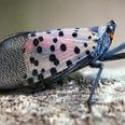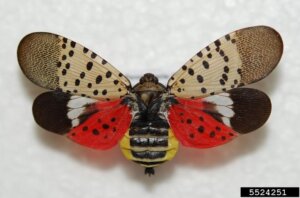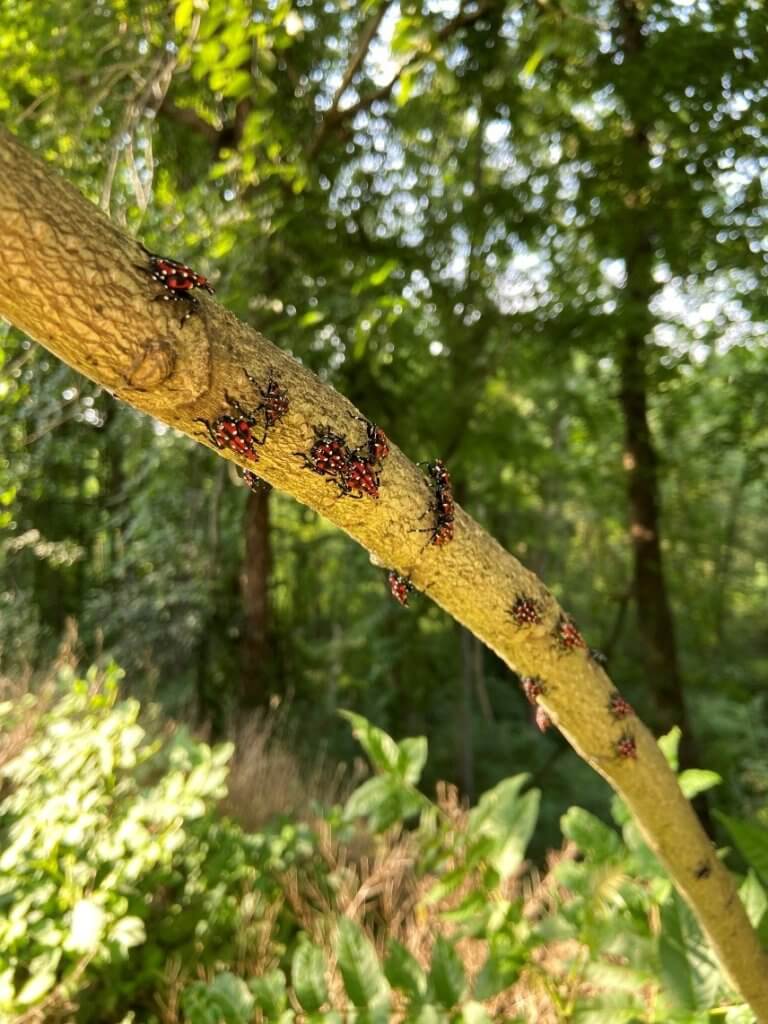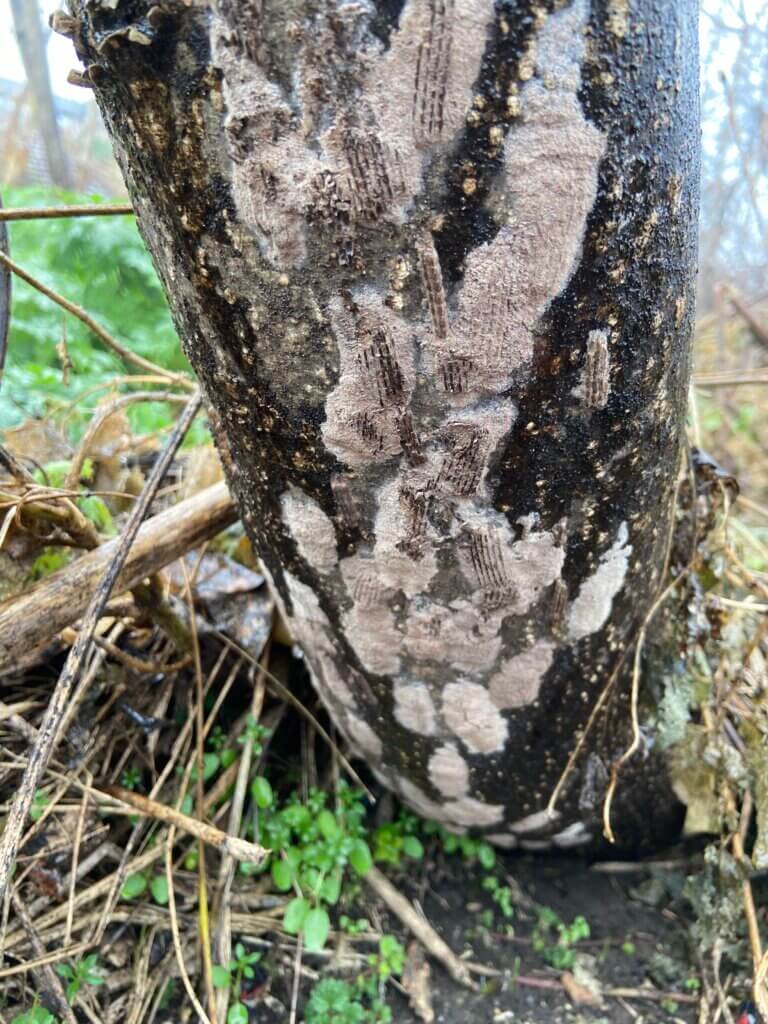
The spotted lanternfly (SLF; Lycorma delicatula) was first detected in the United States in Berks County, Pennsylvania in September 2014 (Pennsylvania Department of Agriculture, 2015). The insect had been present for two years (Spichiger, 2015). It quickly became apparent that the outbreak was wider, and spreading. In 2017 the lanternfly was detected in Delaware, just across the river from the core of the Pennsylvania infestation. In early 2018 the insect was detected in Frederick County, Virginia (which is connected by an interstate highway to the infested area in Pennsylvania); and somewhat later in New Jersey – which also borders on the affected portion of Pennsylvania. The lanternfly outbreak also was spreading in Pennsylvania; by January 2018, the Pennsylvania quarantine included portions of 13 counties in the southeastern part of the state (Pennsylvania Department of Agriculture, 2017).
Spread continued. Individual insects were detected throughout the Northeast as early as 2018. Established outbreaks were detected in Connecticut, Ohio and New York in 2020. More distant outbreaks were found on the Indiana – Kentucky border in July 2021 and in North Carolina and Michigan in 2022. Detections were made in Illinois and Tennessee in September 2023, bringing the total number of states to 17.

It is likely that SLF is more widely distributed. Among the detections of individual insects in distant states (e.g., Kansas and California), immature insects were found in Iowa in 2022. https://www.invasivespeciesinfo.gov/terrestrial/invertebrates/spotted-lanternfly
For the most up to date geographic information, please visit the regional map from New York State Integrated Pest Management, Spotted Lanternfly Reported Distribution Map | CALS (cornell.edu). This map is updated approximately once a month and shows both the individual finds, and known infestation areas. A map showing areas at risk of SFL establishment based on climate and ecological niche models was published in 2019 (Wakie et al. 2019).
As is clear from this history, the spotted lanternfly is very well adapted to long-distance spread via human assistance. SLF lay egg masses on the smooth bark of many host trees, including willow, maple, poplar, sycamore, and fruit trees. [APHIS alert] Of greatest relevance, lanternflies also lay eggs on smooth vertical surfaces of vehicles, campers, rail cars, yard furniture, farm equipment or other items stored outside, or even masonry walls [Pennsylvania Department of Agriculture, 2015). The large number and variety of possible vectors has greatly complicated efforts to prevent spread of the insect.
Larvae Nymphs crawl up the trunk early in the day, then back down in the afternoon or evening, so sticky bands or circle traps are effective in trapping the insect (Spichiger, 2015). Fourth instar nymphs are very active; they can hop several feet (Rhodes 2015). Adults appear as early as July. They are poor flyers, but strong jumpers [Pennsylvania Department of Agriculture, 2015].
In the fall, adults seek tree of heaven (Ailanthus) as the preferred site for egg laying. However, as noted above, lanternflies will use a wide range of smooth vertical surfaces [Pennsylvania Department of Agriculture, 2015].

Infested trees can have weeping wounds of sap on the trunks. As insect populations rise, honeydew secretions build up at the base of the tree, blackening the trunk and the soil around the base. The largest colonies can produce large fungal mats at the base of trees. Wasps, hornets, bees, and ants attracted to the honeydew secretions can become conspicuous (PA DoA, 2015).
The spotted lanternfly is a planthopper native to China; it has been introduced to Korea (in 2004), Vietnam, and Japan [Dara et al. 2015]. Its preferred host is a tree native to those portions of Asia, tree of heaven, Ailanthus altissima; however, in Korea and North America, the lanternfly utilizes a wide range of host plant species. In North America, more than 56 species are known hosts (Barringer and Ciafre, 2020). These include many important agricultural crops, such as wild and cultivated grapes, stone fruits (plums, cherries, peaches, nectarines, apricots, almonds), apples, willow, and various hardwoods [Pennsylvania Department of Agriculture alert; APHIS alert]. SLF oviposits on pines but does not feed on them (Hoover, pers. comm.). A worldwide host plant list published in October 2020 (Barringer, 2020) included the following North American plant taxa: ash, American basswood, American beech, birches, American sycamore, black cherry, black walnut and butternut, blackgum, dogwoods, hickories, maples and boxelder, oaks, sassafras, slippery elm, tulip poplar, and willow. One conifer – eastern white pine – is also listed.
The preferred host, Ailanthus altissima, is a non-native, invasive tree that is widespread in North America. The species is found in forests in 44 ecoregions across North America (Potter, Riitters, and Guo, 2022). The implications are complicated: while few object to killing Ailanthus as part of the SLF control program, the species is nearly ubiquitous along transportation corridors and in other disturbed habitats. It is also difficult to kill; cutting the tree down prompts vigorous sprouting from the roots unless these are killed by appropriate applications of herbicide.
Ailanthus apparently relates to SLF in unique ways. First, one study indicated that it stores significantly higher concentrations of starch and total nonstructural carbohydrates in its roots than to North American tree hosts; these resources might strengthen Ailanthus’ ability to outgrow the negative consequences of heavy feeding by SLF (Hoover et al. 2023). Furthermore, certain toxins manufactured by Ailanthus trees apparently provide SLF some defense against avian predation (Song et al. 2018).
Affected plants and crops are damaged in two ways. First, the loss of sap from stems and leaves reduces photosynthesis and plant health. Second, both the insects and affected plants release large amounts of honeydew, which promotes mold growth that can inhibit photosynthesis (APHIS alert; Urban and Leach 2022).
The USDA Animal and Plant Health Inspection Service (APHIS) rarely becomes involved in addressing agricultural pests found in a single state, however, the detection of the spotted lanternfly in Pennsylvania produced prompt action. Initially, APHIS focused on managing the outer perimeter of the infestation – where natural spread was occurring — while the Pennsylvania Department of Agriculture concentrated on the core infested area and inner perimeter. Pennsylvania established a state quarantine with the goal of reducing human-assisted spread of SLF. The Commonwealth also asked citizens to search for signs of the insect, and take action to reduce lanternfly populations. Those actions included placing adhesive bands around the trunks of Ailanthus altissima trees to trap nymphs and adults moving up the trunk to feed or mate; and scraping egg masses found on plants. The program also removed Ailanthus trees with a quarter-mile radius of detected infestations and mandated proper disposal of green waste. To prevent the Ailanthus trees from resprouting, the herbicide triclopyr was applied on stumps, and the leaves of any re-sprouts from stumps. Finally, a system of trap trees was established: a small number of Ailanthus trees were left standing to attract SLF; the insecticide Dinotefuran was applied as a basal trunk spray to kill them when they began to feed. (While the environmental assessment allows use of imidacloprid, APHIS has avoided that chemical because it is more expensive and less effective than Dinotefuran [USDA APHIS Environmental Assessment, 2023]).
By 2020, APHIS had made several changes in the program: it expanded the number of pesticides used; began switching from sticky bands on the tree trunks to circle traps on the tree trunks; and stopped removing Ailanthus trees, relying instead on killing the trees using herbicides [USDA APHIS Environmental Assessment 2023]
APHIS has never established a federal quarantine for the spotted lanternfly. All regulatory measures have been adopted by the states. In most cases, the regulated articles included brush, debris, bark, or yard waste; logs, stumps, or any tree parts; firewood of any species; grapevines; nursery stock; crates; landscaping, remodeling or construction waste; and a wide range of outdoor household articles such as recreational vehicles, lawn tractors and mowers, mower decks, grills, grill and furniture covers, tarps, mobile homes, tile, stone, deck boards, mobile fire pits, any associated equipment and trucks or vehicles not stored indoors (Pennsylvania Department of Agriculture, 2015).
Despite not implementing a federal quarantine for SLF, APHIS has allocated considerable funds to trying to counter the invasion. As early as 2015, APHIS provided grants totaling $1.5 million under the Farm Bill §7721 Plant Pest and Disease Management and Disaster Prevention Program to Pennsylvania in support of eradication and outreach programs. Funding through this mechanism – which does not depend on annual appropriations by the Congress – has continued. Since 2015, funding for various aspects of the SLF program has reached $25.6 million. Projects have included research into detection methods, possible biocontrol agents, and other control techniques; modeling of spread mechanisms; and outreach to encourage members of the public to avoid moving the many types of objects which can transport the insect, especially egg masses.
In response to the rapid growth of the infested area (i.e., the detection in Virginia), in February 2018 the USDA announced that it had allocated an additional $17.5 million in emergency funds to stop the spread of spotted lanternfly. These funds were transferred from the Commodity Credit Corporation under the authorization in 7 U.S.C. 7772 (Title 7: Agriculture, Chapter 104: Plant Protection, Subchapter IV: Authorization of Appropriations). APHIS used existing resources to conduct surveys, and control measures in Delaware, Maryland, New Jersey, New York and Virginia (USDA Press Release No. 0031.18).
By the summer of 2021, as new outbreaks continued to be detected, APHIS and its partners had determined that the highest-risk pathways of spread are rail lines and intermodal freight facilities. Further, they had discovered that recently hatched SLF nymphs climb vertical objects higher than 5 meters (16.5 feet). APHIS had to adjust its program, specifically pesticide application methods so as to reach these higher sites. In response, APHIS conducted an environmental assessment that considered use of ground-based mist blowers in certain locations [USDA APHIS 2021 Supplemental EA]. Mist blowers are sprayers that use a fan to blow insecticide emitted through nozzles into a directed mist. They are useful for treating large areas and applying insecticide into areas of dense foliage. Use of mist blowers was initially restricted to certain counties in Maryland, Ohio, Virginia, and West Virginia; in Pennsylvania they could be used statewide. By early 2023, APHIS decided to allow use of mist blowers and high-pressure hydraulic systems on rail and road corridors in any state. These corridors span thousands of miles, but the actual treatment area will be limited. Each may affect up to 50 acres [USDA APHIS Environmental Assessment 2023].
In 2023, APHIS’ SLF Program used a combination of control methods, depending on circumstances at the infested site. Components of each program might include any or all of the following: regulatory control through state quarantines; surveys; egg mass scraping; high-pressure water washing to remove egg masses; killing Ailanthus trees primarily by herbicide treatments; application of circle traps to trees; trap trees; and insecticide applications. Detection is primarily through visual searches and inspection of sticky bands and circle traps, although detector canines are also used. https://www.invasivespeciesinfo.gov/terrestrial/invertebrates/spotted-lanternfly Local agricultural officials continue training citizens to scrape egg masses.

To protect the natural environment, human health, and historic structures (the affected states host thousands of buildings on the National Register of Historic Places), APHIS says its contractors will:
- adhere to label restrictions on the pesticides applied through ground-based misters or high-pressure hydraulic systems. These include not applying pesticide when wind direction favors downwind drift towards nearby water bodies; when wind velocity exceeds 5 mph; or when it is raining.
- not treat areas so intensely as to cause run-off.
- not treat within a 150-foot buffer around any aquatic habitat or 500-foot buffer in proximity to federally listed threatened or endangered species and their critical habitats.
- adjust timing of treatments – to the extent practicable – to minimize exposure of pollinators.
- inform owners of apiaries of planned treatment periods so they can move their hives.
- preferably use hand-operated sprayers when applying pesticides near schools, parks, or playgrounds.
- not use high water pressure to remove egg masses from the listed historic sites.
APHIS will also monitor the area to detect any spray drift card or water contamination. If such events are detected, APHIS will adjust its spray program.
Unfortunately, the necessity to treat transportation corridors to control SLF conflicts with a national program aimed at protecting habitat for Monarch butterflies. The Monarch Candidate Conservation Agreement with Assurances encourages energy companies and state departments of transportation to manage their rights-of-way and associated lands to promote habitat for the butterflies [USDA APHIS Environmental Assessment, 2023].
APHIS continues to pursue the possibility that parasitoids might provide biological control of the spotted lanternfly. In North America, spiders and predatory insects attack SLF, but at insufficient levels for dependable control. In early 2023, APHIS was assessing the efficacy and specificity of two Chinese parasitoids, Anastatus orientalis and Dryinus sinicus [USDA APHIS Environmental Assessment, 2023].
While spotted lanternfly feeds on a very wide range of hosts (see above), the level of damage caused remains elusive. Even the damage to grapevines – considered the most significant – is uncertain since it is difficult to distinguish relative contribution of various causes, e.g., winter injury, from SLF feeding [USDA APHIS Environmental Assessment, 2023].
Studies to clarify levels of damage were begun by scientists at the Pennsylvania State University in 2018 or 1019. The damage results from the combination of voracious feeding by individual insects and their high numbers. (In Pennsylvania, more than 100 SLF adults have been observed feeding on a single grape vine [Urban and Leach, 2022].) This level of attack severely depletes the host plants’ resources, especially since adult SLFs extract large quantities of phloem sap over three months or longer (from late August or early September to late fall). As noted, another factor is the growth of sooty mold promoted by copious amounts of honeydew; mold mats further impede photosynthesis (Urban and Leach, 2022).
The result of SLF’s intense predation on plant hosts is reduced growth and, in some cases, death. The impacts are most obvious on grape vines. SLF feeding measurably reduces the vines’ rate of photosynthesis, late-season concentrations of non-structural carbohydrates and nitrogen; and storage of carbon and nitrogen in the roots. At a minimum, these depletions reduce grape yields up to 90% and spoil fruit quality. They can also lead to winter mortality of the vines (Harner et al. 2022).
In Pennsylvania, the annual economic losses from SLF are estimated at $8 million for ornamentals; $16.7 million for forest industries [Harper et al. 2019]. Among tree hosts, Pennsylvania State scientists have studied SLF impacts on silver maple (Acer saccharinum), red maple (Acer rubrum), black walnut (Juglans nigra), weeping willow (Salix babylonica), and river birch (Betula nigra). For details concerning the tree species’ responses to SLF feeding see Lavely et al. (2022) and Hoover et al. (2023). Most of the data discussed by either Lavely or Hoover pertain to comparing the maples’ responses to those of Ailanthus. SLF rarely kills mature trees belonging to the North American species. It does occasionally kill young saplings, specifically of black walnut and maples.
Vulnerability varies considerably among individual trees. This variability has been detected in both “common garden” studies and in the field. Researches have noticed “hot” trees enduring high densities of SLF (nymphs or adults) that are surrounded by others of the same species, size, and apparent health that have few SLF. The university studies were not able to clarify these anomalies (Mason et al. 2020).
Perhaps surprisingly, researchers report that SLF commonly kills Ailanthus of any size when the tree is fed on heavily for several months, especially when the tree is attacked several years in a row (Hoover, pers. comm.).
Caveats. The findings of the studies by Hoover et al. 2023 might exaggerate the impacts of SLF feeding on North American tree species. First, the tests were conducted on young saplings, which are more sensitive than larger trees to SLF. Second, the feeding pressure was maintained on the same trees for four seasons. In nature, SLF moves from host to host frequently, so no individual tree would be subjected to such a continuous, repeated attack across the entire season. Consequently, the eventual impact remains somewhat unclear. Hoover et al. noted that even under the worst case scenario presented by their studies none of the trees in the study died.
On the other hand, as Lavely et al. (2022) and Hoover et al. (2023) point out, trees stressed by other biotic or abiotic factors might be more vulnerable to damage by SLF feeding. Since saplings are more vulnerable, Hoover concludes that greatest potential harm is to the nursery industry. They also recommend protecting the trees from other stresses (Hoover et al. 2023).
In 2022, APHIS joined the National Association of State Departments of Agriculture (NASDA) and National Plant Board to develop a five-year strategy for addressing the threat from spotted lanternfly [USDA APHIS, 2023b]. The Plan has three goals: effectively limit SLF spread; support continued scientific research to develop practical management and risk mitigation measures; and establish a consistent nation-wide outreach message and education campaign.
Under the terms of the Plan, states and APHIS will together identify high-risk dispersal pathways, e.g., truck/distribution centers, railways, airports, maritime ports, and nurseries. Attention would focus on these sites that are within a quarter mile of a known outbreak. State agencies and APHIS will conduct a delimiting survey and identify the most effective management options and approach. State agencies will conduct trace-back operations to determine the outbreak’s origin and method of movement. State agencies and APHIS will internally confirm their legal authority to apply insecticidal controls. Funding priorities will be set jointly by state agencies and APHIS.
In states where SLF has not yet been detected, state agencies should determine their authority to gain access to private property, implement a quarantine, and conduct treatments – either directly or through use of contractors. The state agencies and APHIS will jointly develop plants for surveying high-risk sites. State agencies, APHIS, and other partners will agree on potential treatment and management options. Again, state agencies and APHIS will jointly determine how to focus funding.
State agencies and APHIS will jointly coordinate Federal, state, and partner resources and activities. When using Federal funding, state agencies will adhere to the terms of the pertinent USDA programmatic Environmental Assessment. State agencies and APHIS will conduct periodic assessments on public and industry information needs and use the lessons learned to develop and continuously refine education and outreach plan that communicates need to treat and effectively limit SLF spread.
Concerning continuing research, APHIS will coordinate with state and Federal research agencies and academia to identify data needs (including economic impacts analysis) and ensure that the focus is on developing tools for stakeholders. APHIS will also facilitate data sharing among state, Federal, academic, and industry partners. States will identify issues, provide local expertise and situational awareness, and advocate for legislative support for funding of university researchers. The states will also collect, compile, analyze, and provide state-specific economic impact data. Together, both APHIS and the states will prioritize needs for field operations. Topic areas mentioned for research include improving visual survey techniques and strategies and identifying SLF impacts on several crops, especially grapes, peaches (potentially other stone fruit), hops, and walnuts; and impacts to the lumber industry. Carrying out the identified research agenda depends on available funding.
Finally, the program will build a framework for reporting unexpected impacts of SLF.
For more information, visit:
- Pennsylvania Department of Agriculture Spotted Lanterfly page
- Spotted Lanternfly Information, USDA APHIS
- New York State Integrated Pest Management blog, Have YOU Spotted Lanternfly Egg Masses? – includes a very high quality regional map
SOURCES
Barringer and Ciafré 2020, Worldwide Feeding Host Plants of Spotted Lanternfly, With Significant Additions From North America. Environmental Entomology, Volume 49, Issue 5, October 2020, Pages 999–1011
Dara, S.K., Barringer, L., Arthurs, S.P. 2015. Lycorma delicatula (Hemiptera: Fulgoridae): a new invasive pest in the United States. J Integr Pest Manag. 2015:6(1):20. https://doi.org/10.1093/jipm/pmv021
Harner AD, Leach HL, Briggs L, Centinari M. Prolonged phloem feeding by the spotted lanternfly, an invasive planthopper, alters resource allocation and inhibits gas exchange in grapevines. Plant Direct. 2022:6(10):e452.
Hoover, K., L. Iavorivska, E.K. Lavely, O. Uyi. 2023. Effects of long-term feeding by spotted lanternfly (Hemiptera: Fulgoridae) on ecophysiology of common hardwood host trees. Environmental Entomology, XX(XX), 2023, 1–12 https://doi.org/10.1093/ee/nvad084
Lavely, E. Iavorivska, L., Uyi, O., Eissenstat, D.M., Walsh, B., Primka, E.J. IV, Harper, J. and Hoover, K. 2022 Impacts of short-term feeding by spotted lanternfly (Lycorma delicatula) on ecophysiology of young hardwood trees in a common garden. Front. Insect Sci. 2:1080124. doi: 10.3389/finsc.2022.1080124
Pennsylvania Department of Agriculture. November 2017. Spotted Lanternfly Quarantine Map. If this link is broken, refer here instead.
Pennsylvania Department of Agriculture, Spotted Lanternfly website Accessed August 13 2015 and January 30 2018.
Potter, K.M., Escanferla, M.E., Jetton, R.M., Man, G., Crane, B.S. 2019. Prioritizing the conservation needs of US tree spp: Evaluating vulnerability to forest insect and disease threats. Global Ecology and Conservation, doi: https://doi.org/10.1016/
Potter K.M., Riitters, K.H. and Guo, Q. 2022. Non-native tree regeneration indicates regional and national risks from current invasions. Frontiers in Forests and Global Change doi: 10.3389/ffgc.2022.966407 ]
Rhodes, D. Pennsylvania Department of Agriculture, National Plant Board, August 2015.
Spichiger, S-E. Pennsylvania Department of Agriculture, 26th USDA Interagency Research Forum on Invasive Species, January 2015.
Song S, Kim S, Kwon SW, Lee SI, Jablonski PG. Defense sequestration associated with narrowing of diet and ontogenetic change to aposematic colours in the spotted lanternfly. Sci Rep. 2018:8(1):16831. https://doi.org/10.1038/s41598-018-34946-y
USDA Press Release No. 0031.18 https://www.usda.gov/media/press-releases/2018/02/07/perdue-announces-emergency-funding-spotted-lanternfly-pennsylvania
United States Department of Agriculture Animal and Plant Health Inspection Service. 2021. Spotted Lanternfly Control Program in the Mid-Atlantic Region, North Carolina, Ohio and Kentucky. Supplemental Environmental Assessment. October 2021.
United States Department of Agriculture Animal and Plant Health Inspection Service. 2023a. Expanded Spotted Lanternfly Control Program in Select States in the Midwest, Northeast, and Mid-Atlantic Regions of the United States. Final Environmental Assessment, April 2023
United States Department of Agriculture Animal and Plant Health Inspection Service. 2023b. Spotted Lanternfly Five-Year Strategy. Fiscal Years 2024–2028
Urban, J.M. and H. Leach. 2023. Biology and Management of the Spotted Lanternfly, Lycorma delicatula (Hemiptera: Fulgoridae), in the United States. Annu. Rev.Entomol. 2023. 68:151-67
Wakie T, Neven L, Yee W, Lu Z, The Establishment Risk of Lycorma delicatula (Hemiptera: Fulgoridae) in the United States and Globally, Journal of Economic Entomology, Volume 113, Issue 1, February 2020, Pages 306–314, https://doi.org/10.1093/jee/toz259 and covered in Entomology Today



